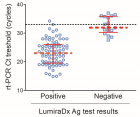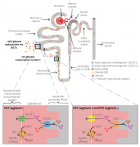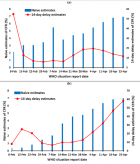Abstract
Research Article
Identification and Infrared Spectroscopic Study of Lapachol, β-Lapachone and Hydroxy-hydrolapachol
Miquéias Ferreira Gomes, Ginandrya Rodrigues Araújo, Ziom Drak Souza Silva, Raquel Maria Ferreira de Sousa and Herbert Júnior Dias*
Published: 06 July, 2023 | Volume 7 - Issue 1 | Pages: 028-035
Metabolites of Brazilian Cerrado species are considered an immense font of biologically active compounds The diversity of organic compounds generated by the secondary metabolism of various Cerrado plants draws attention especially because many of these compounds have the capacity to be structurally modified and, consequently, produce other very interesting derivatives for pharmacological purposes. Despite this, little is described in the literature about fast, easy, and accessible identification methods for any laboratory, such as infrared spectroscopy. In this sense, this work demonstrates the synthesis and elucidation through spectroscopic techniques of lapachol and its synthetic derivatives. Through quick and simple extractions or reactions, lapachol, β-lapachone, and hydroxy-hydrolapachol were obtained with adequate yields. From this, the main FTIR absorptions of the mentioned naphthoquinones are described, which facilitates the identification of these metabolites with high biological potential. The present work contributes could become a simpler source of data for extraction, synthesis, and spectroscopic characterization by FTIR of the compounds.
Read Full Article HTML DOI: 10.29328/journal.apps.1001041 Cite this Article Read Full Article PDF
Keywords:
Ipê-roxo; Metabolites; FTIR; Elucidation
References
- Borlaug NE. Feeding a world of 10 billion people: The miracle ahead. Biotechnology & Biotechnological Equipment. 1997; 11(3–4):3–13. https://doi.org/10.1080/13102818.1997.10818934
- Klink CA, Machado RB. Conservation of the Brazilian Cerrado. Conservation Biology. 2005; 19(3):707–713. https://doi.org/10.1111/j.1523-1739.2005.00702.x
- Ribeiro Neto JA, Pimenta Tarôco BR, Batista Dos Santos H, Thomé RG, Wolfram E, Maciel de A Ribeiro RI. Using the plants of Brazilian Cerrado for wound healing: From traditional use to scientific approach. J Ethnopharmacol. 2020 Oct 5; 260:112547. doi: 10.1016/j.jep.2020.112547. Epub 2020 Jan 7. PMID: 31917276.
- Deforestation in the Cerrado in 2018. http://combateaodesmatamento.mma.gov.br/images/Doc_ComissaoExecutiva/Balanco-PPCDAm-e-PPCerrado_2018.pdf
- Carvalho PER. Brazilian Tree Species (1st ed.). Embrapa Technological Information. 2003; 1.
- Grose SO, Olmstead RG. Taxonomic revisions in the polyphyletic genus Tabebuia I. (Bignoniaceae). Systematic Botany. 2007; 32(3):660–670. https://doi.org/10.1600/036364407782250652
- Duke JA. Handbook of Medicinal Herbs (2nd ed.). CRC Press. 2002.
- Gómez Castellanos JR, Prieto JM, Heinrich M. Red Lapacho (Tabebuia impetiginosa)-a global ethnopharmacological commodity? J Ethnopharmacol. 2009 Jan 12;121(1):1-13. doi: 10.1016/j.jep.2008.10.004. Epub 2008 Nov 1. PMID: 18992801.
- Sacau EP, Estévez-Braun A, Ravelo AG, Ferro EA, Tokuda H, Mukainaka T, Nishino H. Inhibitory effects of lapachol derivatives on epstein-barr virus activation. Bioorg Med Chem. 2003 Feb 20;11(4):483-8. doi: 10.1016/s0968-0896(02)00542-4. PMID: 12538012.
- Barbosa-Filho JM, Lima CSA, Amorim ELC, Sena KXF, Almeida JRG, da-Cunha EVL, Silva MS, Agra M de F, Braz-Filho R. Botanical study, phytochemistry and antimicrobial activity of Tabebuia aurea. Phyton (Buenos Aires). 2004; 73: 221–228.
- El-Hawary SS, Taher MA, Amin E, Fekry AbouZid S, Mohammed R. Genus Tabebuia: A comprehensive review journey from past achievements to future perspectives. Arabian Journal of Chemistry. 2021; 14(4):103046. https://doi.org/10.1016/j.arabjc.2021.103046
- Lee MH, Choi HM, Hahm DH, Her E, Yang HI, Yoo MC, Kim KS. Analgesic and anti-inflammatory effects in animal models of an ethanolic extract of Taheebo, the inner bark of Tabebuia avellanedae. Mol Med Rep. 2012 Oct;6(4):791-6. doi: 10.3892/mmr.2012.989. Epub 2012 Jul 17. PMID: 22825254.
- Suo M, Isao H, Kato H, Takano F, Ohta T. Anti-inflammatory constituents from Tabebuia avellanedae. Fitoterapia. 2012 Dec;83(8):1484-8. doi: 10.1016/j.fitote.2012.08.014. Epub 2012 Aug 29. PMID: 22955001.
- Zhang L, Hasegawa I, Ohta T. Iridoid Esters from Tabebuia avellanedae and Their In Vitro Anti-inflammatory Activities. Planta Med. 2017 Jan;83(1-02):164-171. doi: 10.1055/s-0042-110322. Epub 2016 Jun 28. PMID: 27352388.
- Pereira IT, Burci LM, da Silva LM, Baggio CH, Heller M, Micke GA, Pizzolatti MG, Marques MC, Werner MF. Antiulcer effect of bark extract of Tabebuia avellanedae: activation of cell proliferation in gastric mucosa during the healing process. Phytother Res. 2013 Jul;27(7):1067-73. doi: 10.1002/ptr.4835. Epub 2012 Sep 12. PMID: 22969019.
- Twardowschy A, Freitas CS, Baggio CH, Mayer B, dos Santos AC, Pizzolatti MG, Zacarias AA, dos Santos EP, Otuki MF, Marques MC. Antiulcerogenic activity of bark extract of Tabebuia avellanedae, Lorentz ex Griseb. J Ethnopharmacol. 2008 Aug 13;118(3):455-9. doi: 10.1016/j.jep.2008.05.013. Epub 2008 May 18. PMID: 18579323.
- Coelho JM, Antoniolli AB, Nunes e Silva D, Carvalho TM, Pontes ER, Odashiro AN. O efeito da sulfadiazina de prata, extrato de ipê-roxo e extrato de barbatimão na cicatrização de feridas cutâneas em ratos [Effects of silver sulfadiazine, ipê roxo (tabebuia avellanedae) extract and barbatimão (stryphnodendron adstringens) extract on cutaneous wound healing in rats]. Rev Col Bras Cir. 2010 Feb;37(1):45-51. Portuguese. doi: 10.1590/s0100-69912010000100010. PMID: 20414576.
- de Miranda FG, Vilar JC, Alves IA, Cavalcanti SC, Antoniolli AR. Antinociceptive and antiedematogenic properties and acute toxicity of Tabebuia avellanedae Lor. ex Griseb. inner bark aqueous extract. BMC Pharmacol. 2001;1:6. doi: 10.1186/1471-2210-1-6. Epub 2001 Sep 13. PMID: 11574048; PMCID: PMC56902.
- Choi WH, Ahn J, Jung CH, Jang YJ, Ha TY. β-Lapachone Prevents Diet-Induced Obesity by Increasing Energy Expenditure and Stimulating the Browning of White Adipose Tissue via Downregulation of miR-382 Expression. Diabetes. 2016 Sep;65(9):2490-501. doi: 10.2337/db15-1423. Epub 2016 May 31. PMID: 27246910.
- Iwamoto K, Fukuda Y, Tokikura C, Noda M, Yamamoto A, Yamamoto M, Yamashita M, Zaima N, Iida A, Moriyama T. The anti-obesity effect of Taheebo (Tabebuia avellanedae Lorentz ex Griseb) extract in ovariectomized mice and the identification of a potential anti-obesity compound. Biochem Biophys Res Commun. 2016 Sep 23;478(3):1136-40. doi: 10.1016/j.bbrc.2016.08.081. Epub 2016 Aug 15. PMID: 27539320.
- Freitas AE, Machado DG, Budni J, Neis VB, Balen GO, Lopes MW, de Souza LF, Veronezi PO, Heller M, Micke GA, Pizzolatti MG, Dafre AL, Leal RB, Rodrigues AL. Antidepressant-like action of the bark ethanolic extract from Tabebuia avellanedae in the olfactory bulbectomized mice. J Ethnopharmacol. 2013 Feb 13;145(3):737-45. doi: 10.1016/j.jep.2012.11.040. Epub 2012 Dec 10. PMID: 23237932.
- Cwikla C, Schmidt K, Matthias A, Bone KM, Lehmann R, Tiralongo E. Investigations into the antibacterial activities of phytotherapeutics against Helicobacter pylori and Campylobacter jejuni. Phytother Res. 2010 May;24(5):649-56. doi: 10.1002/ptr.2933. PMID: 19653313.
- Fernandez A, Cock IE. Tabebuia impetiginosa(Mart. Ex DC. Mattos) bark extracts inhibit the growth gastrointestinal bacterial pathogens and potentiate the activity of some conventional antibiotics. Pharmacognosy Communications. 2020; 10(2):75–82. https://doi.org/10.5530/pc.2020.2.15
- Mehmood Y, Ashraf MI, Rana S, Riaz H, Raza SA, Khan Z. mohy-ud-din. Anti-pseudomonas aeruginosa drug; to evaluate bactericidal activity of Tabebuia Impetiginosa against pseudomonas aeruginosa and its synergistic effect with common antipseudomonas aeruginosa drug prof. The Professional Medical Journal. 2018; 25(10):1574–1580. https://doi.org/10.29309/TPMJ/18.4509
- Ali A, Kiderlen A, Kolodziej H. Lapachol and isomeric 5- and 8-hydroxy-2-(1′-hydroxyethyl) naphtho[2,3-b] furan-4,9-diones are effective antileishmanial constituents of Tabebuia avellanedae. Planta Medica. 2010; 76(12). https://doi.org/10.1055/s-0030-1264769
- Brandão GC, Kroon EG, dos Santos JR, Stehmann JR, Lombardi JA, Braga de Oliveira A. Antiviral activity of Bignoniaceae species occurring in the State of Minas Gerais (Brazil): part 1. Lett Appl Microbiol. 2010 Oct;51(4):469-76. doi: 10.1111/j.1472-765X.2010.02924.x. PMID: 20840554.
- Brandão GC, Kroon EG, Santos JR. dos Stehmann JR, Lombardi JA, Oliveira AB de. Antiviral activities of plants occurring in the state of Minas Gerais, Brazil: Part 2. Screening Bignoniaceae species. Revista Brasileira de Farmacognosia. 2010; 20(5):742–750. https://doi.org/10.1590/S0102-695X2010005000035
- Borges JCM, Haddi K, Oliveira EE, Andrade SB, Nascimento VL, Melo ST, Didonet J, Carvalho JCT, Cangussu AS, Soares IM, Ascencio SD, Raposo NRB, Aguiar RWS. Mosquiticidal and repellent potential of formulations containing wood residue extracts of a Neotropical plant, Tabebuia heptaphylla. Industrial Crops and Products. 2019; 129:424–433. https://doi.org/10.1016/j.indcrop.2018.12.022
- Budni P, Petronilho FC, Citadini-Zanette V, Marcondes C, Zoch AN, Reginatto FH, Dal-Pizzol F. Preliminary studies of the antioxidant activity of adult and young leaf extract hydroetanolic of Tabebuia heptaphylla (Vell.) Toledo (ipê-roxo). Latin American Journal of Pharmacy. 2007; 26(3):394–398.
- Telang N, Nair HB, Wong GYC. Growth inhibitory efficacy and anti-aromatase activity of Tabebuia avellanedaein a model for post-menopausal Luminal A breast cancer. Biomed Rep. 2019 Nov;11(5):222-229. doi: 10.3892/br.2019.1244. Epub 2019 Oct 3. PMID: 31632670; PMCID: PMC6792322.
- Zhang L, Tatsuno T, Hasegawa I, Tadano T, Ohta T. Furanonaphthoquinones from Tabebuia avellanedae induce cell cycle arrest and apoptosis in the human non-small cell lung cancer cell line A549. Phytochemistry Letters. 2015; 11: 9–17. https://doi.org/10.1016/j.phytol.2014.09.013
- Hellwig P. Infrared spectroscopic markers of quinones in proteins from the respiratory chain. Biochim Biophys Acta. 2015 Jan;1847(1):126-33. doi: 10.1016/j.bbabio.2014.07.004. Epub 2014 Jul 12. PMID: 25026472.
- Sousa ET, Lopes WA, Andrade JB de. Sources, formation, reactivity and determination of quinones in the atmosphere. Química Nova. 2016; 39(4):486–495. https://doi.org/10.5935/0100-4042.20160034
- Schmeda-Hirschmann G, Papastergiou F. Naphthoquinone derivatives and lignans from the Paraguayan crude drug "tayï pytá" (Tabebuia heptaphylla, Bignoniaceae). Z Naturforsch C J Biosci. 2003 Jul-Aug;58(7-8):495-501. doi: 10.1515/znc-2003-7-809. PMID: 12939034.
- Yamashita M, Kaneko M, Tokuda H, Nishimura K, Kumeda Y, Iida A. Synthesis and evaluation of bioactive naphthoquinones from the Brazilian medicinal plant, Tabebuia avellanedae. Bioorg Med Chem. 2009 Sep 1;17(17):6286-91. doi: 10.1016/j.bmc.2009.07.039. Epub 2009 Jul 23. PMID: 19674905.
- Epifano F, Genovese S, Fiorito S, Mathieu V, Kiss R. Lapachol and its congeners as anticancer agents: a review. Phytochemistry Reviews. 2014; 13(1):37–49. https://doi.org/10.1007/s11101-013-9289-1
- Oliveira KM, Honorato J, Demidoff FC, Schultz MS, Netto CD, Cominetti MR, Correa RS, Batista AA. Lapachol in the Design of a New Ruthenium(II)-Diphosphine Complex as a Promising Anticancer Metallodrug. J Inorg Biochem. 2021 Jan;214:111289. doi: 10.1016/j.jinorgbio.2020.111289. Epub 2020 Oct 23. PMID: 33137682.
- de Andrade JKF, da Silva Góes AJ, Barbosa VX, de Lima Silva MS, Matos Donato MA, Peixoto CA, Militão GCG, da Silva TG. Anticancer activity of β-Lapachone derivatives on human leukemic cell lines. Chem Biol Interact. 2022 Sep 25;365:110057. doi: 10.1016/j.cbi.2022.110057. Epub 2022 Aug 5. PMID: 35934135.
- Nirmala MJ, Samundeeswari A, Sankar PD. Natural plant resources in anti-cancer therapy-A review. Research in Plant Biology. 2011; 1(3):1–14.
- Baulsir CF, Simler RJ. Design and evaluation of IR sensors for pharmaceutical testing. Advanced Drug Delivery Reviews. 1996; 21(3):191–203. https://doi.org/10.1016/S0169-409X(96)00407-3
- Yap KY-L, Chan SY, Lim CS. Infrared-based protocol for the identification and categorization of ginseng and its products. Food Research International. 2007; 40(5):643–652. https://doi.org/10.1016/j.foodres.2006.11.009
- Tu-ya Yang P, Sun S, Zhou Q, Bao X, Noda I. Analysis of fingerprints features of infrared spectra of various processed products of Radix Aconiti kusnezoffii. Journal of Molecular Structure. 2010; 974(1–3):103–107. https://doi.org/10.1016/j.molstruc.2010.01.008
- Barbosa TP, Neto DH. Preparation of lapachol derivatives in acid and base media: proposed experiments for Organic Chemistry laboratory classes. Química Nova. 2013; 36(2):331–334. https://doi.org/10.1590/S0100-40422013000200021
- Alves GMC, Rolim LA, Neto RPJ, Leite ACL, Brondani DJ, Medeiros FPM, de Bieber LW, Mendonça Junior FJB. Purification and characterization of β-lapachone and stability study of the crystals under different storing conditions. Química Nova. 2008; 31(2):413–416. https://doi.org/10.1590/S0100-40422008000200039
- Pettit GR, Houghton LE. Lapachol. Canadian Journal of Chemistry. 1968; 46(14): 2471–2472. https://doi.org/10.1139/v68-404
- Burgula Y, Khali D, Kim S, Krishnan SS, Cousin MA, Gore JP, Reuhs BL, Mauer LJ. Review of mid-infrared fouritransform-infrared spectroscopy applications for bacterial detection. Journal of Rapid Methods and Automation in Microbiology. 2007; 15(2), 146–175. https://doi.org/10.1111/j.1745-4581.2007.00078.x
- Wartewig S, Neubert RH. Pharmaceutical applications of Mid-IR and Raman spectroscopy. Adv Drug Deliv Rev. 2005 Jun 15;57(8):1144-70. doi: 10.1016/j.addr.2005.01.022. PMID: 15885850.
- Origin Lab Corporation (2001) Origin Pro, Version 6.1 (6.1). Origin Lab Corporation.
- Pettit GR, Houghton LE. Synthesis of hydroxyhydrolapachol and lapachol. Journal of the Chemical Society C: Organic. 1971; 1(0): 509–511. https://doi.org/10.1039/j39710000509
- Salas C, Tapia RA, Ciudad K, Armstrong V, Orellana M, Kemmerling U, Ferreira J, Maya JD, Morello A. Trypanosoma cruzi: activities of lapachol and alpha- and beta-lapachone derivatives against epimastigote and trypomastigote forms. Bioorg Med Chem. 2008 Jan 15;16(2):668-74. doi: 10.1016/j.bmc.2007.10.038. Epub 2007 Oct 18. PMID: 18029184.
- Pavia DL, Lampman GM, Kriz GS, Vyvyan JR. Introduction to Spectroscopy (5th ed.). Cengage Learing. 2011.
- Heneczkowski M, Kopacz M, Nowak D, Kuźniar A. Infrared spectrum analysis of some flavonoids. Acta Poloniae Pharmaceutica. 2001; 58(6): 415–420.
- Rostkowska H, Nowak MJ, Lapinski L, Adamowicz L. Molecular structure and infrared spectra of 2-hydroxy-1,4- naphthoquinone; Experimental matrix isolation and theoretical Hartree–Fock and post Hartree–Fock study. Spectrochimica Acta Part A: Molecular and Biomolecular Spectroscopy. 1998; 54(8): 1091–1103. https://doi.org/10.1016/S1386-1425(98)00032-8
- Costa RA, da Silva JN, Oliveira KMT, Dutra LM, Costa EV. Quantum chemical studies, vibrational analysis, molecular dynamics and docking calculations of some ent-kaurane diterpenes from Annona vepretorum: a theoretical approach to promising anti-tumor molecules. Structural Chemistry. 2020; 31(3): 1223–1243. https://doi.org/10.1007/s11224-020-01491-2
- Fleming I, Williams D. Infrared and Raman Spectra. In Spectroscopic Methods in Organic Chemistry. Springer International Publishing. 2019; 85-121.https://doi.org/10.1007/978-3-030-18252-6_3
- Benassi R, Ferrari E, Lazzari S, Spagnolo F, Saladini M. Theoretical study on Curcumin: A comparison of calculated spectroscopic properties with NMR, UV–vis and IR experimental data. Journal of Molecular Structure. 2008; 892(1–3): 168–176. https://doi.org/10.1016/j.molstruc.2008.05.024
- Koczón P, Lewandowski W, Mazurek AP. Vibrational (FT-IR and FT-Raman) and NMR studies on selected metal (Ca, Mn, Zn) complexes with ortho-, meta-, and para-iodobenzoic acids. Vibrational Spectroscopy. 1999; 20(2): 143–149. https://doi.org/10.1016/S0924-2031(99)00032-6
- Morin P, Pichard H, Pichard H, Caude M, Rosset R. Supercritical fluid chromatography of sesquiterpene hydrocarbons on silica packed columns with on-line Fourier transform infrared detection. Journal of Chromatography A. 1991; 464: 125–137. https://doi.org/10.1016/S0021-9673(00)94229-8
- Delarmelina M, Ferreira GB, Ferreira VF, de M Carneiro JW. Vibrational spectroscopy of lapachol, α- and β-lapachone: Theoretical and experimental elucidation of the Raman and infrared spectra. Vibrational Spectroscopy. 2016; 86: 311–323. https://doi.org/10.1016/j.vibspec.2016.08.009
- Ilčin M, Holá O, Bakajová B, Kučerík J. FT-IR study of gamma-radiation induced degradation of polyvinyl alcohol (PVA) and PVA/humic acids blends. Journal of Radioanalytical and Nuclear Chemistry. 2010; 283(1): 9-13. https://doi.org/10.1007/s10967-009-0321-2
- Karabulut S, Namlı H. An FT-IR and DFT based new approach for the detection of tautomer proportions in solution. Journal of Molecular Structure. 2012; 1024: 151-155. https://doi.org/10.1016/j.molstruc.2012.05.029
- Rao KS, St-Jean F, Kumar A. Quantitation of a ketone enolization and a vinyl sulfonate stereoisomer formation using inline IR spectroscopy and modeling. Organic Process Research & Development. 2019; 23(5), 945–951. https://doi.org/10.1021/acs.oprd.9b00042
- Cahyana AH, Nazhifah N, Liandi AR. One-pot four-component synthesis of phenazine derivative using 2-hydroxy-1,4-naphthoquinone. IOP Conference Series: Materials Science and Engineering. 2020; 902(1): 012020. https://doi.org/10.1088/1757-899X/902/1/012020
- Kordić B, Kovačević M, Sloboda T, Vidović A, Jović B. FT-IR and NIR spectroscopic investigation of hydrogen bonding in indole-ether systems. Journal of Molecular Structure. 2017; 1144: 159–165. https://doi.org/10.1016/j.molstruc.2017.05.035
- Howard RW, Baker JE, Morgan ED. Novel diterpenoids and hydrocarbons in the Dufour gland of the ectoparasitoid Habrobracon hebetor (Say) (Hymenoptera: Braconidae). Arch Insect Biochem Physiol. 2003 Nov;54(3):95-109. doi: 10.1002/arch.10104. Erratum in: Arch Insect Biochem Physiol. 2004 Feb;55(2):102. PMID: 14571504.
- Kovács A, Keresztury G, Izvekov V. Intramolecular hydrogen-bonding in 2-nitroresorcinol. A combined FT-IR, FT-Raman and computational study. Chemical Physics. 2000; 253(2–3): 193-204. https://doi.org/10.1016/S0301-0104(99)00390-0
Similar Articles
-
Anticancer activity of novel surface functionalized metal doped hydroxyapatiteSaheli Pradhan*,Shouvik Mitra,Arunava Goswami. Anticancer activity of novel surface functionalized metal doped hydroxyapatite. . 2020 doi: 10.29328/journal.apps.1001023; 4: 021-026
-
Identification and Infrared Spectroscopic Study of Lapachol, β-Lapachone and Hydroxy-hydrolapacholMiquéias Ferreira Gomes, Ginandrya Rodrigues Araújo, Ziom Drak Souza Silva, Raquel Maria Ferreira de Sousa, Herbert Júnior Dias*. Identification and Infrared Spectroscopic Study of Lapachol, β-Lapachone and Hydroxy-hydrolapachol. . 2023 doi: 10.29328/journal.apps.1001041; 7: 028-035
Recently Viewed
-
Agriculture High-Quality Development and NutritionZhongsheng Guo*. Agriculture High-Quality Development and Nutrition. Arch Food Nutr Sci. 2024: doi: 10.29328/journal.afns.1001060; 8: 038-040
-
A Low-cost High-throughput Targeted Sequencing for the Accurate Detection of Respiratory Tract PathogenChangyan Ju, Chengbosen Zhou, Zhezhi Deng, Jingwei Gao, Weizhao Jiang, Hanbing Zeng, Haiwei Huang, Yongxiang Duan, David X Deng*. A Low-cost High-throughput Targeted Sequencing for the Accurate Detection of Respiratory Tract Pathogen. Int J Clin Virol. 2024: doi: 10.29328/journal.ijcv.1001056; 8: 001-007
-
A Comparative Study of Metoprolol and Amlodipine on Mortality, Disability and Complication in Acute StrokeJayantee Kalita*,Dhiraj Kumar,Nagendra B Gutti,Sandeep K Gupta,Anadi Mishra,Vivek Singh. A Comparative Study of Metoprolol and Amlodipine on Mortality, Disability and Complication in Acute Stroke. J Neurosci Neurol Disord. 2025: doi: 10.29328/journal.jnnd.1001108; 9: 039-045
-
Development of qualitative GC MS method for simultaneous identification of PM-CCM a modified illicit drugs preparation and its modern-day application in drug-facilitated crimesBhagat Singh*,Satish R Nailkar,Chetansen A Bhadkambekar,Suneel Prajapati,Sukhminder Kaur. Development of qualitative GC MS method for simultaneous identification of PM-CCM a modified illicit drugs preparation and its modern-day application in drug-facilitated crimes. J Forensic Sci Res. 2023: doi: 10.29328/journal.jfsr.1001043; 7: 004-010
-
A Gateway to Metal Resistance: Bacterial Response to Heavy Metal Toxicity in the Biological EnvironmentLoai Aljerf*,Nuha AlMasri. A Gateway to Metal Resistance: Bacterial Response to Heavy Metal Toxicity in the Biological Environment. Ann Adv Chem. 2018: doi: 10.29328/journal.aac.1001012; 2: 032-044
Most Viewed
-
Evaluation of Biostimulants Based on Recovered Protein Hydrolysates from Animal By-products as Plant Growth EnhancersH Pérez-Aguilar*, M Lacruz-Asaro, F Arán-Ais. Evaluation of Biostimulants Based on Recovered Protein Hydrolysates from Animal By-products as Plant Growth Enhancers. J Plant Sci Phytopathol. 2023 doi: 10.29328/journal.jpsp.1001104; 7: 042-047
-
Sinonasal Myxoma Extending into the Orbit in a 4-Year Old: A Case PresentationJulian A Purrinos*, Ramzi Younis. Sinonasal Myxoma Extending into the Orbit in a 4-Year Old: A Case Presentation. Arch Case Rep. 2024 doi: 10.29328/journal.acr.1001099; 8: 075-077
-
Feasibility study of magnetic sensing for detecting single-neuron action potentialsDenis Tonini,Kai Wu,Renata Saha,Jian-Ping Wang*. Feasibility study of magnetic sensing for detecting single-neuron action potentials. Ann Biomed Sci Eng. 2022 doi: 10.29328/journal.abse.1001018; 6: 019-029
-
Pediatric Dysgerminoma: Unveiling a Rare Ovarian TumorFaten Limaiem*, Khalil Saffar, Ahmed Halouani. Pediatric Dysgerminoma: Unveiling a Rare Ovarian Tumor. Arch Case Rep. 2024 doi: 10.29328/journal.acr.1001087; 8: 010-013
-
Physical activity can change the physiological and psychological circumstances during COVID-19 pandemic: A narrative reviewKhashayar Maroufi*. Physical activity can change the physiological and psychological circumstances during COVID-19 pandemic: A narrative review. J Sports Med Ther. 2021 doi: 10.29328/journal.jsmt.1001051; 6: 001-007

HSPI: We're glad you're here. Please click "create a new Query" if you are a new visitor to our website and need further information from us.
If you are already a member of our network and need to keep track of any developments regarding a question you have already submitted, click "take me to my Query."

















































































































































